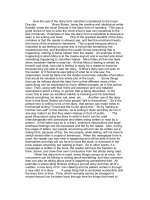televised violence is here to stay
Bạn đang xem bản rút gọn của tài liệu. Xem và tải ngay bản đầy đủ của tài liệu tại đây (33.53 KB, 3 trang )
Televised Violence is Here to Stay One of the most heated issues
debated, ever since the invention of the television, is the effects of media
violence on society. Many try to wipe it out, but will undoubtedly fail. It has
great educational and entertainment value. There have even been
studies showing that viewing television violence will actually relieve
stress. For these reasons, televised violence, including fights, with or
without weapons, resulting in bloodshed, will never diminish. Many
parents try to shelter their kids from the violence portrayed on television.
They only look at the negative aspect because the parents complain by
saying the violence only teaches their children how to kill and to get away
with it (Leonard 92). Television is the most credible and believable
source of information on the reality of the world. It teaches that the world
is a violent and untrustworthy place (Bennett 168). It reports on how the
world really works. Televised violence cultivates dominant assumptions
about how conflict and power work in the world. Violence is an
important fact of life (Howitt 17). It is very much part of the human
condition. The media cannot pretend that violence does not exist.
Televised violence orients people to their environment. It helps them
understand their world. It serves as a mirror in which people examine
themselves, their institutions, and their values (Comstock 357). The
exposure of children to televised violence is functional to the extent that it
prepares them to cope with reality. Conflict is important for children to
grow up with. It is part of their life. Kids should not be lead to think that
nothing is going to happen to them (Comstock 354). Exposure to violence
in childhood is not a bad idea. Ghetto children see violence unknown to
other children. They have to live with it, and because it is so hateful, they
do not get influenced by it. People who grew up in a tough ghetto
situation regard others who did not as patsies, naive, and easy to use.
Children learn a good deal of their society's culture by viewing the
violent television shows. People acquire definitions of appropriate
behavior and interpretations of reality from the mass media. Lower
income persons often think they are learning the style and etiquette of
middle-class society from television programs (Ball 305). The viewing
of televised violence helps children academically, as well as socially. One
study shows that children entering school, raised on the violent television
shows, picked up a one-year advantage in vocabulary over children
whose parents prohibit the viewing of violence (Clark 136). Here, the
positive effects clearly outweigh the negative. There have been many
attempts to ban violence from television. The majority of the viewers
prevent the idea through the ratings. There is a discrepancy between
public attitudes and private behavior; while people may publicly condemn
television violence, they may actually enjoy it in private (Howitt 6). The
majority of people get whatever they want in the mass media. There is
substantial public demand for violence. The key question is: Why? To a
large extent, the answer to this question lies in the social and cultural
structure of society. Violence constitutes a significant and recurring theme
in the value structure (Leonard 91). There can be little doubt that
topics of violence are of intense interest to the public and attract large
audiences. Television gives people what they want to see. In
entertainment, it is a more acceptable truism to assert that the supply
creates the demand. Leisure time cries for fulfillment (Lineberry 24).
Violence is the dominant theme of all mass media. The audience
ratings do correlate positively with the percentages of violent programs.
Violent types of programs gain great popularity; networks regard violence
as good bait. It is a tool for attracting audiences (Howitt 124). Mass
media organizations spend countless hours producing and presenting
entertainment, and the American public spend a comparable amount of
time in consumption of such productions. The media identifies
entertainment drama with conflict. Conflict translates into action, and
action is equal with violence (Lineberry 21). The networks make violence
their prime test for inclusion in their content. The significance of
violence is that it helps define, move, and resolve dramatic situations
(Comstock 29). Violence allows conflict to be quickly establish or resolve;
it is visual and understandable; it is attractive to large segments of the
audience. There is indeed violence in the real world, and to ignore it in
drama is in effect to lie. There will never be a cure for the addiction to
violence. Media viewers hunger for the violent action on the television.
The people speak through ratings, showing that violent programs are
exceedingly popular (Lineberry 23). Some parents believe that
violence, whether portrayed as fantasy or reality, will arouse aggression
or increase aggressive behavior. They think it will harden their kids to
human pain and suffering. These parents also believe that the televised
violence will lead them to accept violence as a solution to personal and
social problems, creating an increase in social delinquency (Zuckerman
64). However, such exposure has precisely the opposite effect. Viewing
violence on television will allow the media user to discharge in fantasy
what he might otherwise act out (Ball 239). It provides a safe and
harmless outlet for human frustrations and aggressive-hostile impulses in
much the same manner as hitting a punching bag. The viewing of
aggressive scenes brings about a reduction in the aggressive drives of
the viewer. Children get rid of hostility feelings in an innocuous way by
watching violent television programs. These programs provide a
necessary social function by presenting young people with a harmless
outlet for latent hostility and by enabling them to relieve their pent-up
aggression (Larsen 143). It is wrong to blame television for outbreaks of
violence and the alleged increase in crime and delinquency rates. Many
factors other than exposure to the media, such as relationships and
experiences with parents, brothers, sisters, teachers, and companions,
cause real life violence. Interaction in primary groups (such as the family)
develops the human personality. As a child matures, he undergoes a
process of social preparation for adult roles. Much of this preparation
ordinarily takes place in the family, while some of it occurs in play groups
and formal education. It occurs all the time the child is awake and active,
even when he and the persons with whom he interacts are not
consciously concerned with shaping his character. He becomes a residue
of what he has done and experienced, which in turn depends on his
genetic endowment and the social heritage into which he was born. If
there is any "social damage," it is the faults of the home, the school, the
neighborhood, or other social settings (Larsen 141). Exposure to violent
stimuli has no effect on already established attitudinal commitments
regarding violent mortality. Empirical research has found no evidence that
exposures to explicit violent materials play a significant role in the
causation of delinquency or criminal behavior among youth and adults
(Clark 131). Television violence does not cause one to act out aggressive
actions. Although many critics object to the viewing of televised
violence, there are too many reasons explaining why it will never
disappear. Parents who prohibit their children from viewing violent topics
will shelter them too much from the reality of the world. Violence on the
television is essential. People need to know what is happening in the
world (Tuchscherer 95). Those who would prefer to avoid exposure to the
media's portrayal of violence have the option to turn off the television set.
Doing this, however, will only result in their loss.









